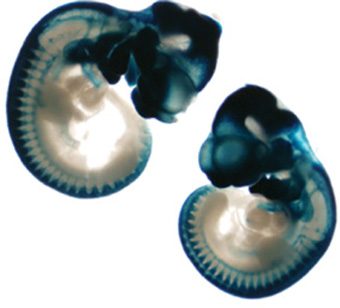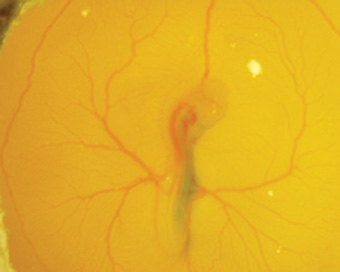A series of discoveries revealed new types of RNA that play a key role in controlling intracellular processes in the development of the organism

The double helix of DNA represents for us the molecule of life, which includes all the genetic information and the instructions for building a living organism. Until recently, biology was dominated by the concept that the creation of proteins begins when genetic information encoded in DNA is transformed, in the process of transcription, into molecules of RNA, the single-stranded cousin of DNA. Therefore, it's no wonder that RNA, considered a humble blender of messages and information about building proteins, has lived for so long in the shadow of its shining cousin, the "real thing", DNA. But almost 50 years later, new discoveries have completely changed our understanding of gene control processes, turning the spotlight on RNA.
What is known as the "RNA revolution" in molecular biology resulted from a series of discoveries about new types of RNA that are not just messengers, but play a key role in controlling intracellular processes and the development of the organism. One such family of RNA molecules is called microRNA. These are small molecules, whose main function is the control of gene expression. How do they do it? They bind to messenger RNA molecules, and do not allow them to transmit the information necessary to build proteins. This process is called "interference using RNA", and it is an effective means of controlling and regulating the production of various proteins. Dr. Eran Hornstein, from the Department of Molecular Genetics at the Weizmann Institute of Science, investigates the role of microRNA coding genes in the control of gene expression, within the framework of the development of animals and humans, in normal situations and during disease. Dr. Hornstein: "We know that when certain genes accumulate mutations, the result is disease. But we don't know what happens when a gene that codes for microRNA accumulates mutations.

Can defective microRNA cause disease? Will the difference in the control mechanism lead to a different disease? If microRNA is indeed involved in genetic diseases, it may be possible to develop new treatments that will focus on the recently discovered microRNA genes."
In his research, he focuses on the role of microRNA in the development of the pancreas, bone and cartilage. He examines how genetic defects in these tissues can lead to common diseases, such as diabetes, cleft palate and bone loss. "Cancer is also caused by genetic disruptions", he says, "therefore studying the meanings of disruptions in microRNA function can provide new insights into the roles of small RNA molecules in cancer diseases."
To find out which segments of microRNA are involved in different processes, and what is the result of this involvement, the members of Dr. Hornstein's research group use mice whose genetic load lacks the genes encoding certain segments of microRNA. In this way, they were able to discover that if the microRNA activity in the beta cells of the pancreas is disabled (which are responsible for producing insulin, which controls blood sugar levels) - the mice show signs of diabetes. Scientists are now characterizing the molecular mechanisms that control this complex process.
In another study, the members of the group examine the contribution of microRNA to the development of skeletal tissues. For example, if the microRNA is removed from these tissues by genetic methods, serious phenomena such as the absence of a skull, dwarfism or cleft palate may occur during the process of fetal development. Dr. Hornstein and the members of the research group he heads are currently engaged in deciphering the genetic pathways that go wrong in these cases, and in identifying the specific microRNA molecules that participate in the process.

Dr. Hornstein: "Scientists are just beginning to understand the real effects of genes from the microRNA family, both in the normal development of the organism and during disease. New knowledge in this field may lead to the development of new treatments that will focus on previously unknown mechanisms. Thus, scientists around the world have already developed synthetic versions of microRNA that are used for advanced medical treatments."
Eran Hornstein was born in Jerusalem in 1971. After five years of military service, he was accepted to the medical school of the Hebrew University and Hadassah. "I went to medical school with the goal of becoming a doctor, but I was also interested in science and decided to engage in basic research at the same time. That's how I ended up in the lab of Prof. Oded Miyochas in the biochemistry department of the Hebrew University," he says. Medical studies were exciting, but Hornstein was more attracted to basic research, and after completing his medical residency, he did postdoctoral research under the guidance of Prof. Cliff Tabin at Harvard Medical School, where he focused on developmental biology.
"I feel that my background and medical studies influence my world of associations and my tendency to investigate basic molecular and genetic mechanisms involved in diseases. It's important to me to carry out research that has an impact on people's health." In 2006, Dr. Hornstein joined the Weizmann Institute of Science as a senior researcher. His research group includes seven research students and three postdoctoral researchers.
In the same topic on the science website:

2 תגובות
Ami:
The article actually presents the fact that the existence of RNAI has already been discovered before.
Not in the very distant past but still in the past.
Good luck to the researcher and his interesting research.
There is a bit of a problem with the wording because it gives the impression that RNAi is something new and unknown to science.
We have known the phenomenon for quite some time, although the research is still in its infancy and as stated in the article there is still much to learn from the phenomena of RNA interference on physiology.